Sauron in the First Age
‘Among those of Morgoth’s servants that have names, the greatest was that spirit whom the Eldar call Sauron, or Gorthaur the Cruel. In his beginning he was of the Maia of Aulë and he remained mighty in the lore of that people. In all the deeds of Melkor the Morgoth upon Arda…Sauron had a part.’ (J.R.R. Tolkien, ‘Valaquenta’, The Silmarillion).
Sauron was Morgoth’s most feared servant and is said to be only less evil than his master because he, for a time, served one other than himself. The character of Sauron had a role in the first, second and third ages of Middle-earth and, being a Maia, was present from the beginning. Sauron’s name means ‘Abhorred’, however, he had many other: The Dark Lord Annatar, The Necromancer, The Sorcerer, Gorthaur (the Cruel), The Lord of Gifts and The Ring-Maker. He was the lieutenant of Morgoth and was given control of Angband, one of the two fortresses (Utumno and Angband) that Melkor built prior to the coming of the Elves. When the Valar made war on Melkor and held him in the duress of Mandos for three ages, they failed to search out all the vaults and caverns of his strongholds, and thus Sauron eluded capture.
Sauron continued to grow in sorcery and twisted whatever he ruled to evil. When Morgoth returned, Sauron resumed his role of terror and following the death of Fingolfin, he lead a force against Minas Tirith on Tol Sirion. The city had long withstood the forces of Morgoth, however Sauron took it by assault, sending before him a cloud of fear on its defenders. The city became a watchtower for Morgoth and the island of Tol Sirion became known as the Tol-in-Gaurhoth, the Isle of Werewolves.
As Morgoth’s power increased, he sent Sauron to find the dwelling of the outlaws of Dorthonion, who were led by Barahir and to destroy them. Sauron discovered that Gorlim, a companion of Barahir, would come at times to visit the house where he had once dwelt with his wife, Eilinel. Their love had been great and Gorlim returned to the house in hope that she was still alive and one day would return. Unknown to Gorlim, Eilinel was dead, but by his sorcery, Sauron created an image of Eilinel in the window of their house and captured Gorlim. Being promised to be reunited with his wife and unable to bear the torture of Sauron’s gaze, Gorlim told all he knew of the outlaws dwelling. Sauron then revealed to Gorlim his deceit and put him cruelly to death. Morgoth’s armies surrounded the remaining outlaws and destroyed the people of Barahir, save Beren son of Barahir. Beren soon grew to be a feared outlaw and Sauron was sent to eliminate him. He led a huge army against Beren, forcing him into Dungortheb, where he eventually found his way into Doriath.
Beren later set forth from Doriath and was joined by Felagund on a quest to capture one of the Silmarils and so win the hand of Lúthien, daughter of Thingol. However, the group took on the guise of Orcs and were captured by Sauron who, stripping them of their disguise, cast them into the dungeons of Tol-in-Gaurhoth. Here all save Beren were killed at the hand of Sauron’s wolves.
One of Sauron’s worst defeats followed, when Huan and Lúthien arrived to rescue Beren. One by one Sauron’s wolves were slain and, eventually taking on the form of a wolf, Sauron ventured forth from his stronghold to battle with them. However Huan proved the victor and Sauron was forced to yield the tower to them. Fleeing from Tol-in-Gaurhoth, Sauron went to dwell in Taur-nu-fuin, making it a place of terror.
Sauron in the Second Age
At the end of the First Age, a great host was led from Valinor by the Herald of Manwë, Eönwë, against Morgoth. They were victorious and Thangorodrim, the stronghold of Morgoth, was broken and Morgoth was overthrown and put into the Void. Sauron, seeing his master’s defeat, put on his fair hue again and asked pardon of Eönwë. However, he was commanded by Eönwë to return to Aman and receive the judgement of Manwë, as it was not in his authority to give pardon to one of his order. Sauron, being too full of pride to accept the thought of serving the Valar (as his power under Morgoth had been great) hid himself in Middle-earth and refused the commands of Eönwë.
Feeling the Valar had again forgotten Middle-earth, Sauron’s pride grew. He sought ever to corrupt the Eldar and travelled amongst them in the form of one wise and fair. He chose for himself the name Annatar, which means Lord of Gifts. In many places he was received gladly, however, the land of Lindon was closed to him, as Gil-galad and Elrond did not trust him. In Eregion, land of the jewel smiths, he was gladly received and having been a Maia of Aulë in the beginning, he had skill in this area and the Noldor learnt much from him. It was at this time that Celebrimbor, greatest jewel smith since Fëanor, created the three Elven Rings and he alone had a hand in their making. They had the power to ward off the decays of time and postpone the weariness of the world. Sauron, seeing these, forged the Ruling Ring to control the three, as they were withheld from him and kept by the wise. Now wishing to control the other peoples of Middle-earth, he gathered to himself the other Rings of Power (of which he had at least a part in the making) and gave seven to the Dwarves and nine to the Men. Men proved easiest to sway and the nine he gave the Rings to fell into shadow and became known as the Ringwraiths. The wise perceived the treachery of Sauron and did not use the Three while he held the Ruling Ring. Realising he had not deceived the Elves, Sauron made war on them, demanding that the Rings be surrendered to him, but the Elves fled and the three were hidden from him.
From that time the war between Sauron and the Eldar did not cease and Celebrimbor was killed and the land of Eregion was laid to waste. Sauron’s pride increased and he wished to have dominion over all Middle-earth. He took the name Sauron, Lord of the Earth, and to those opposing him, he was known as the Dark Lord or the Enemy. War continued, but Lindon which was ruled by Gil-galad remained a stronghold, and Sauron dared not attack this land. However, for a time Sauron left Middle-earth, having been taken captive by the Númenóreans and for a while his onslaught upon Middle-earth was stayed.
Now the land of Númenórë was a gift from the Valar to the three kindreds of the Edain for aiding them in the war against Morgoth at the end of the First Age. The land was named Andor, meaning Land of Gift, and it was drawn out of the oceans by Ossë and was established and enriched by Aulë and Yavanna. Elros, brother of Elrond, who was of the Half-Elven, was given the choice of which kindred he would belong to. Choosing to belong to the kindred of Men, he was appointed the first King of Númenor, as he was descendent from the Three kindreds, but also from Maia and Elf. The Númenóreans were given a life-span longer than that of normal Men and for many years they had a strong friendship with the Elves and learnt much of them, growing in splendour and power.
As the Men of Númenórë grew in might, Sauron hated them more, not only because of the deeds of their fathers and their alliance with the Elves, but also because of their allegiance to the Valar. Judging his strength not enough, he withdrew his forces from the coasts, however, among the men ensnared by the Nine rings, three were Lords of Númenor. And when the Ringwraiths arose, Sauron began to assail the strongholds of Númenor upon the coasts.
However, in these days the Men of Númenor grew to distrust the Valar and looked to Aman seeking immortality. As the Kings of Númenor rebelled, the Valar withheld counsel and protection from them and the Elves of Eressëa visited them no more. As Sauron began to attack the strongholds of Númenor on the coast and went by the name of Lord of the Earth, Ar-Pharazôn, King of Númenor set sail with a great host into the East against him. Ar-Pharazôn was a proud King and had a strong hatred for the Elendili (those who kept friendship with the Elves) and wished to compel Sauron to be his servant. Marching on Middle-earth, Ar-Pharazôn called Sauron to come forward and swear fealty. When Sauron appeared, he perceived that the Lords of the Sea were yet too powerful for him, so he put on his hue of one fair and wise and humbled himself before Ar-Pharazôn.
Ar-Pharazôn was not deceived, but brought Sauron back over the Sea to dwell in Númenor as a hostage. But Sauron saw this to his advantage and decided he would gain through wit and cunning what he could not by force. Through flattery and his deceiving appearance, Sauron hid his innermost thoughts and within three years became one of the King’s Chief Counsellors. Sauron’s influence over the King became very strong, to the point that he soon convinced him to fell the White Tree. However Isildur, having heard that this may happen, slipped into the courtyard and took a fruit from the tree. He was attacked, but escaped with the fruit, unrecognised. That sapling grew among the Faithful and was guarded by them. It was not long after this act of bravery that Sauron’s will prevailed and the King felled the White Tree. Sauron then built a great temple to Morgoth and it was there that many of the Faithful were killed, as sacrifices to Morgoth. As the days grew darker, the Men of Númenor began to kill each other and were quick to anger and ever death came to them sooner than of old and King Ar-Pharazôn became the worst tyrant since the days of Melkor. It was then that Amandil, father of Elendil and leader of the Faithful, seeing the darkness of those days, ventured to sail against the ban of the Valar, to Valinor, and speak with Manwë, as did Eärendil of old. He took with him three servants and counselled his son to have the Faithful place on ships all that was dear to them and to board those ships, in preparation for the case in which he did not return, knowing that they would be forced into exile.
Ever Sauron ruled from behind the throne, and Ar- Pharazôn, being full of pride, made ready his army and went to war on the Valar. In that hour Manwë called upon the might of Ilúvatar and a great chasm opened in the water and all the fleets of Númenor were drawn down into the abyss. Those that had set foot with Ar-Pharazôn in Aman were covered by falling hills. The lands of Aman and Eressëa were removed from the reach of Men forever and the Land of Andor was utterly destroyed. Of the Faithful that remained with Elendil and did not go forth with the forces of Ar- Pharazôn, all were spared the destruction of that day and by the grace of the Valar, a great wind was sent and carried the ships of Elendil and his sons Isildur and Anárion away, coming at last to Middle-earth. At this time Sauron also fell down into the abyss, but being of the Maiar, his spirit escaped and returned to Middle-earth, taking up again his great Ring in his fortress of Barad-dûr, along with an image of malice and hate. Few could endure the Eye of Sauron. The evil he wrought in Númenor had been great and never again could he put on his hue of one wise and fair.
Upon his return, Sauron found that the power of his enemies had grown and the lands of Gil-galad now spread widely across the north and the west. It was also then that Isildur and Anárion founded the lands of Gondor and Arnor, their chief cities being Minas Ithil and Minas Anor. Elendil arrived in the land of Lindon, where he was befriended by Gil-galad and established his realm beyond Ered Luin, with his chief city at Annúminas. Seeing these realms newly developed, Sauron came with great force and took the city of Minas Ithil, turning it into a place of dread. Isildur escaped, taking with him a seedling of the White Tree. Then he sailed up the River with his wife and sons, in search of Elendil. Gil-galad and Elendil now took counsel together and perceived that unless the free peoples of Middle-earth should unite and come against Sauron, he would overthrow them one by one. Therefore the Last Alliance was formed and Elendil and Gil-galad marched East into Middle-earth and gathered with them a great host of Men and Elves. Then they marched against the forces of Sauron and passed into Mordor, encompassing Sauron’s fortress. For seven years they laid siege on it, suffering great loss, for Sauron sent forth fire and darts upon them. At last Sauron, having sent many sorties against them, came forward himself and wrestled with Elendil and Gil-galad, slaying them both. But in this Sauron was also overthrown and Isildur cut from his hand the Ring of Power and took with him the shards of Narsil, his father’s sword which had broken under him as he fell.
Sauron in the Third Age
After the overthrow of Sauron at the end of the Second Age, Elrond and Círdan counselled Isildur to cast the Ring into the fires of Mount Doom, so that it would be unmade and the power of Sauron utterly destroyed. However Isildur did not listen and claimed he was taking it as a weregild for the death of his farther and brother. Returning to Minas Anor and giving counsel to his brother’s son, Meneldil, Isildur left the city, planning to take up his father’s realm in Eriador.
On the way, Isildur planned to go to Imladris, as this was where he had left his wife and youngest son. He also sought counsel with Elrond, as he had realised that he could not wield the Ring. Feeling his enemies were overthrown, Isildur set no guard and between Greenwood and the Great River, at the Gladden Fields, his company was attacked by a large host of Orcs. Being urged by his eldest son to save the Ring and arrive at Rivendell at all costs, Isildur put on the Ring, making himself invisible to all. Coming to the Great River he plunged in, but the Ring betrayed him and the Orcs shot him with many arrows from the banks of the River. The Ruling Ring was lost and for over 2000 years none knew where it lay.
In time a shadow began to grow in the land of Greenwood and it became known as Mirkwood. The fortress of Dol Guldur was built and its dweller became known as the Sorcerer of Dol Guldur and was feared by many, however, few realised that this ‘Sorcerer’ was Sauron returning to Middle-earth.
It was around this time that the Istari arrived and first began to meddle in the affairs of Middle-earth. Of these there were five and they were known as wizards to Men: Mithrandir (Gandalf), Curunír (Saruman), Radagast, Pallando and Alatar. It was said they were sent by the Lords of the West to combat Sauron, should he arise again.
As the Shadow in Dol Guldur increased, the line of the Kings in Gondor and Arnor broke and the Dúnedain became a wandering people. However, Elrond harboured the heirs of Isildur in Rivendell, as he foresaw that one would arise and there would once again be a King of Men.
Gandalf visited the fortress of Dol Guldur, but Sauron fled before him and the Watchful Peace began. It came to an end when Sauron returned to Dol Guldur, now with increased might. Gandalf once again visited the fortress, discovering that the Sorcerer was indeed Sauron and not one of the Nazgûl, as they had long supposed.
Following this the White Council was formed; its members included Galadriel, Elrond, Círdan and other lords of the Eldar, as well as Mithrandir (Gandalf) and Curunír (Saruman). Saruman was appointed the Head of the Council. Upon his return from Dol Guldur, Gandalf urged the Council to take swift action against Sauron. However, Saruman over-ruled him, saying that he did not think the Ring would ever be found again in Middle-earth, yet he secretly wanted the Ring for himself and his servants began to search the Gladden Fields. Sauron however had also learnt of Isildur’s death and his servants were also searching the paths of the River. Seeing this, Saruman fortified Isengard and began to delve further into the lore of the Rings and their making.
As Sauron’s power grew, Gandalf once again urged the Council to take action against him, as soon he would not need the Ring to make war again on Middle-earth. This Saruman consented to, desiring Sauron to be removed from Dol Guldur, which was near the River, so he could not search there any longer. However, Sauron had foreseen this and had sent the Nine to make ready his coming to Mordor, and the wise could not stop him re-entering Mordor.
Yet, unknown to the Wise, the Ring had been found by one of the river-folk many years before and they had taken it deep under the Misty Mountains. From there it had come into the keeping of a Hobbit and was taken to the land of the Periannath or Halflings. It was Mithrandir who first discovered its whereabouts and The Ring was brought to Rivendell by one of these folk and the wise took counsel. They decided that the Ring must be taken into Mordor and be destroyed in the fires of Mount Doom. A Hobbit was appointed this task and a group of companions were sent with him, that became known as the Fellowship of the Ring. It was during that time that the War of the Ring began and Sauron attacked many places of Middle-earth, sending either his forces or using Saruman’s treachery. It was also in those days that the heir of Isildur came forward, he was Aragorn son of Arathorn, and the shards of Narsil were reforged. He was more like Elendil than all his fathers before him and he fought in many battles in the War of the Ring, before finally leading an army against the Black Gates. However, the strength of Sauron was still too great and all would have failed. But it was in that moment that the Ring was destroyed by the fires of Mount Doom, for the mission of the Fellowship had succeeded and Sauron was completely destroyed.
by Elvishmusician
References:
J.R.R. Tolkien, The Silmarillion, Unfinished Tales, The Lord of the Rings
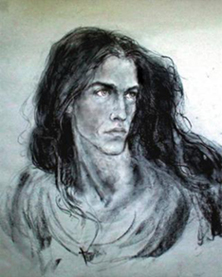 ”Tears unnumbered ye shall shed; and the Valar will fence Valinor against you, and shut you out, so that not even the echo of your lamentation shall pass over the mountains. On the House of Fëanor the wrath of the Valar left from the West unto the uttermost East, and upon all who follow them it shall be laid also. Their Oath shall drive them, and yet betray them, and ever snatch away the very treasures that they have sworn to pursue. To evil end shall all things turn that they begin well; and by treason of kin unto kin, and the fear of treason, shall this come to pass. The Dispossessed shall they be for ever.
”Tears unnumbered ye shall shed; and the Valar will fence Valinor against you, and shut you out, so that not even the echo of your lamentation shall pass over the mountains. On the House of Fëanor the wrath of the Valar left from the West unto the uttermost East, and upon all who follow them it shall be laid also. Their Oath shall drive them, and yet betray them, and ever snatch away the very treasures that they have sworn to pursue. To evil end shall all things turn that they begin well; and by treason of kin unto kin, and the fear of treason, shall this come to pass. The Dispossessed shall they be for ever.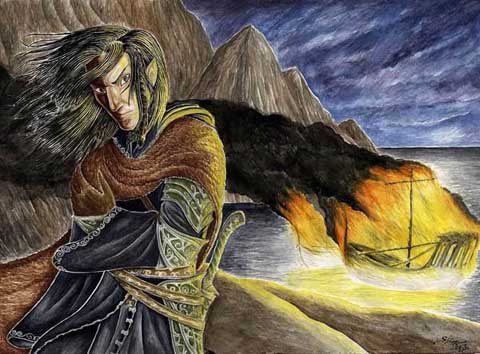 However this was only one consequence out of many; all the years that the Noldor spent in Middle-earth are marked by betrayal, the death and killing of kindred: Maeglin, when he reveals the location of Gondolin to Melkor; Celegorm and Curufin, who betray and backstab their cousin Finrod Felagund, when the latter asks for help for his own people, while trying to fulfil his promise to Beren. The great kingdoms of Nargothrond and Gondolin soon disappear, plundered by dragons, balrogs and orcs, and though their first kings may have died before that happened, many others remained still to face the day of these great cities’ fall. Even in latter days, after the curse is said to have been lifted, Galadriel is forced to face the fall of her own land, Lothlórien, which must have been the most beautiful of that Age, but also Eregion in the Second Age.
However this was only one consequence out of many; all the years that the Noldor spent in Middle-earth are marked by betrayal, the death and killing of kindred: Maeglin, when he reveals the location of Gondolin to Melkor; Celegorm and Curufin, who betray and backstab their cousin Finrod Felagund, when the latter asks for help for his own people, while trying to fulfil his promise to Beren. The great kingdoms of Nargothrond and Gondolin soon disappear, plundered by dragons, balrogs and orcs, and though their first kings may have died before that happened, many others remained still to face the day of these great cities’ fall. Even in latter days, after the curse is said to have been lifted, Galadriel is forced to face the fall of her own land, Lothlórien, which must have been the most beautiful of that Age, but also Eregion in the Second Age.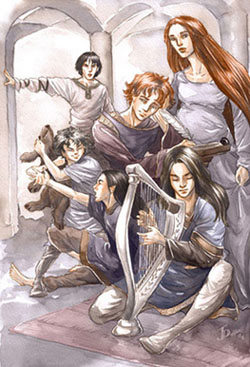 Even when victory had been achieved over Melkor, it was by the Vanyar and not the Noldor, who had spent centuries fighting for it. They would have to wait to be pardoned, until in disgrace they returned to the West, where the Teleri forgave them the past. And despite the greatness of the Noldor, the fact that the Vanyar accomplished what they had not must have been a shame to such proud people.
Even when victory had been achieved over Melkor, it was by the Vanyar and not the Noldor, who had spent centuries fighting for it. They would have to wait to be pardoned, until in disgrace they returned to the West, where the Teleri forgave them the past. And despite the greatness of the Noldor, the fact that the Vanyar accomplished what they had not must have been a shame to such proud people.







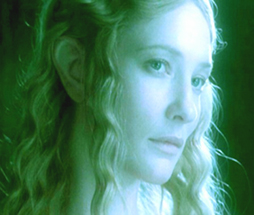 Galadriel grew up in the Bliss of Valinor before the Ages of the Sun began, and being the daughter of the Noldo/Vanyarin Finarfin and the Teleri princess Earwen, she had friendship with all the houses of the Eldar. However it was not long after she had grown to womanhood that the shadows of Melkor spread to the blessed lands and Galadriel was marked by it. Talented, wise and beautiful Galadriel had the potential of many things, though like many Noldor, she was proud and stubborn by nature, and not even her reverence for the Valar, nor her mild and generous nature could quell her desire to rule mighty lands in foreign areas of the world. A just wish it would seem, for among the Eldar her only equal was Fëanor whom she never thought of kindly.
Galadriel grew up in the Bliss of Valinor before the Ages of the Sun began, and being the daughter of the Noldo/Vanyarin Finarfin and the Teleri princess Earwen, she had friendship with all the houses of the Eldar. However it was not long after she had grown to womanhood that the shadows of Melkor spread to the blessed lands and Galadriel was marked by it. Talented, wise and beautiful Galadriel had the potential of many things, though like many Noldor, she was proud and stubborn by nature, and not even her reverence for the Valar, nor her mild and generous nature could quell her desire to rule mighty lands in foreign areas of the world. A just wish it would seem, for among the Eldar her only equal was Fëanor whom she never thought of kindly.  Looking closely, we can see her character changing ever so slightly mainly due to the influence of Melian and Galadriel’s own realisation that Middle-earth isn’t quite like she first thought. She had never experienced armies of Morgoth attacking the lands before. Melian’s influence greatly affected Galadriel as she saw a strong female ruler, this probably encouraged her all the more to rule her own land, but seeing a positive example equipped her better for the task. It’s said that Galadriel was the only female to stand with the princes on the day the Noldor left Valinor, and her mother’s name for her, Nerwen, meant man-maiden. Melian, however, taught her that a female could also rule in partnership with a male.
Looking closely, we can see her character changing ever so slightly mainly due to the influence of Melian and Galadriel’s own realisation that Middle-earth isn’t quite like she first thought. She had never experienced armies of Morgoth attacking the lands before. Melian’s influence greatly affected Galadriel as she saw a strong female ruler, this probably encouraged her all the more to rule her own land, but seeing a positive example equipped her better for the task. It’s said that Galadriel was the only female to stand with the princes on the day the Noldor left Valinor, and her mother’s name for her, Nerwen, meant man-maiden. Melian, however, taught her that a female could also rule in partnership with a male.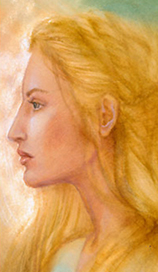 In the Third Age we see a dramatic change of character (that no doubt has come to the surface after her many challenges). She is wise and regarded as this by many. Those around her feel comfortable talking to her and expressing their fears. She offers encouragement to many that would be considered weak by others. Finally she passes the final test of everything she has ever longed for. The Ring of Power comes within her grasp and in her wisdom she rejects it, freeing herself from the lust of power that had been evident for so long in her youth. In the Second Age she lacked the strength to destroy even the lesser of the Rings of Power, however, she grew in wisdom and offered encouragement and support to those who wished to destroy the One Ring. She is also quite selfless in this act, as her own Ring, the Ring of Adamant, will no longer have power, and the beauty of the elves will fade.
In the Third Age we see a dramatic change of character (that no doubt has come to the surface after her many challenges). She is wise and regarded as this by many. Those around her feel comfortable talking to her and expressing their fears. She offers encouragement to many that would be considered weak by others. Finally she passes the final test of everything she has ever longed for. The Ring of Power comes within her grasp and in her wisdom she rejects it, freeing herself from the lust of power that had been evident for so long in her youth. In the Second Age she lacked the strength to destroy even the lesser of the Rings of Power, however, she grew in wisdom and offered encouragement and support to those who wished to destroy the One Ring. She is also quite selfless in this act, as her own Ring, the Ring of Adamant, will no longer have power, and the beauty of the elves will fade.
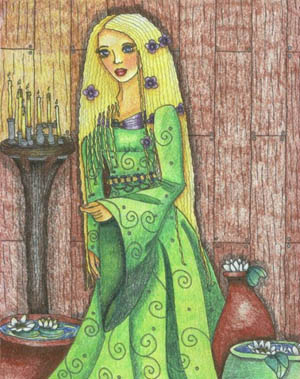 Courtney Brady
Courtney Brady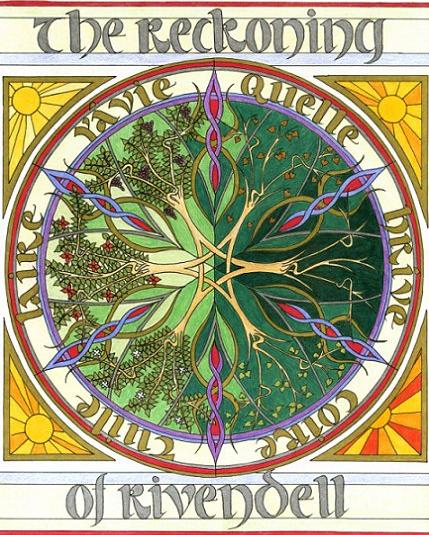 atalante_star
atalante_star Rosearialelven
Rosearialelven Maija Pietikäinen
Maija Pietikäinen